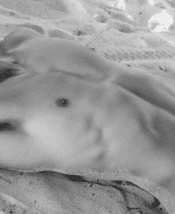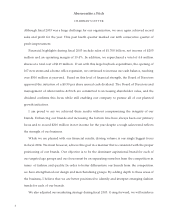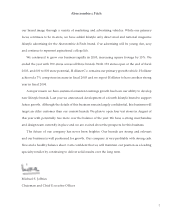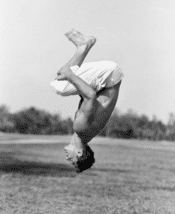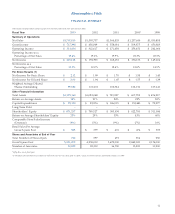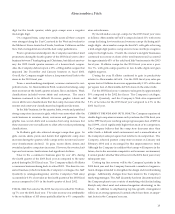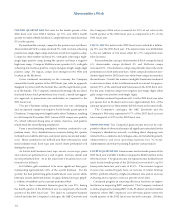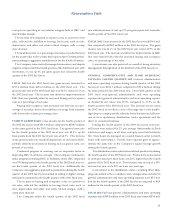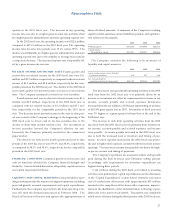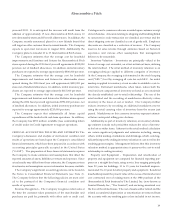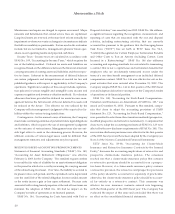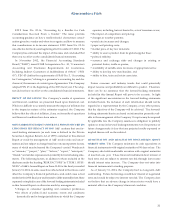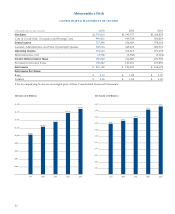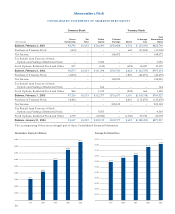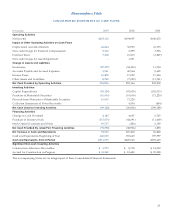Abercrombie & Fitch 2003 Annual Report Download - page 17
Download and view the complete annual report
Please find page 17 of the 2003 Abercrombie & Fitch annual report below. You can navigate through the pages in the report by either clicking on the pages listed below, or by using the keyword search tool below to find specific information within the annual report.
concepts are operating at very similar margins, both in IMU and
merchandise margin.
The increase in buying and occupancy costs, as a percent of net
sales, reflected the inability to leverage fixed costs, such as rent,
depreciation and other real estate related charges, with a comp
store decrease.
The markdown rate, as a percentage of net sales, exceeded last year
for the quarter due to the weaker than expected pre-Christmas busi-
ness resulting in aggressive markdowns in the back half of January.
The Company conservatively managed its inventory and despite
negative comps ended the fourth quarter of the 2003 fiscal year with
inventories, at cost, up 3% per gross square foot versus the fourth
quarter of the 2002 fiscal year.
FISCAL 2003 For the 2003 fiscal year, gross income increased to
$717.4 million from $656.0 million in the 2002 fiscal year. The
gross income rate in the 2003 fiscal year was 42.0% versus 41.1% in
the 2002 fiscal year. The increase was driven by improvements in
IMU that were partially offset by increased buying and occupancy
costs as a percentage of net sales.
Buying and occupancy costs increased over last year, as a per-
centage of net sales, due to the inability to leverage fixed expenses
with lower sales volume per average store.
FOURTH QUARTER 2002 Gross income for the fourth quarter of
the 2002 fiscal year was $243.0 million compared to $208.5 million
in the same period in the 2001 fiscal year. The gross income rate
for the fourth quarter of the 2002 fiscal year was 45.5%, up 80
basis points from the 2001 fiscal year rate of 44.7%. The increase
in the gross income rate resulted largely from an increase in IMU,
partially offset by an increase in buying and occupancy costs, as a
percent of net sales.
Continued progress in sourcing was an important factor in
improving IMU in all three concepts. The Company continued to
make progress increasing IMU in Hollister, where IMU improved
over 700 basis points in the fourth quarter of the 2002 fiscal year ver-
sus the fourth quarter of the 2001 fiscal year. Additionally, the
Company’s less aggressive approach to promotions during the fourth
quarter of the 2002 fiscal year resulted in selling at higher average
retail prices compared to the fourth quarter of the 2001 fiscal year.
The increase in buying and occupancy costs, as a percent of
net sales, reflected the inability to leverage fixed costs, such as
rent, depreciation and other real estate related charges, with a
comp store decrease.
The Company ended the fourth quarter of the 2002 fiscal
year with inventories, at cost, up 12% per gross square foot versus the
fourth quarter of the 2001 fiscal year.
FISCAL 2002 Gross income for the 2002 fiscal year was $656.0 mil-
lion compared to $558.0 million in the 2001 fiscal year. The gross
income rate was 41.1% in the 2002 fiscal year versus 40.9% in the
2001 fiscal year. The increase was driven by improvements in IMU
that were almost fully offset by increased buying and occupancy
costs, as a percentage of net sales.
Gross income was also protected as a result of strong inventory
management through most of the first half of the 2002 fiscal year.
GENERAL, ADMINIST RATIVE AND STORE OPERATING
EXPENSES: FOURTH QUARTER 2003 General, administrative
and store operating expenses during fourth quarter of the 2003
fiscal year were $106.7 million compared to $93.4 million during
the same period in the 2002 fiscal year. The fourth quarter of the
2003 fiscal year general, administrative and store operating
expense rate (general, administrative and store operating expens-
es divided by net sales) was 19.0% compared to 17.5% in the
fourth quarter of the 2002 fiscal year. The increase in rate versus
the 2002 fiscal year reflects a loss of leverage due to the double-
digit drop in comps partially offset by lower bonuses and efficien-
cies in store operations, distribution center operations and the
direct to consumer business.
During the fourth quarter of the 2003 fiscal year, store pay-
roll hours were reduced by 2% per average Abercrombie & Fitch
adult store and wages, in all three concepts, were held relatively
flat. Store hours are managed on a weekly basis in order to match
hours with sales volume. Overall, store expenses grew at approx-
imately the same rate as the Company’s square footage growth
during the fourth quarter.
The distribution center achieved record level productivity during
the fourth quarter of the 2003 fiscal year. Productivity, as measured
in units processed per labor hour, was 18% higher than the fourth
quarter of the 2002 fiscal year. This increase was on top of a 39%
increase last year and a 50% increase two years ago.
Costs related to the distribution center, excluding direct ship-
ping costs related to the e-commerce and catalogue sales, included in
general, administrative and store operating expenses were $5.5 mil-
lion for the fourth quarter of the 2003 fiscal year compared to $4.9
million for the fourth quarter of the 2002 fiscal year.
FISCAL 2003 Full year general, administrative and store operating
expenses were $385.8 million in the 2003 fiscal year versus $343.4 mil-
Abercrombie &Fitch
15


